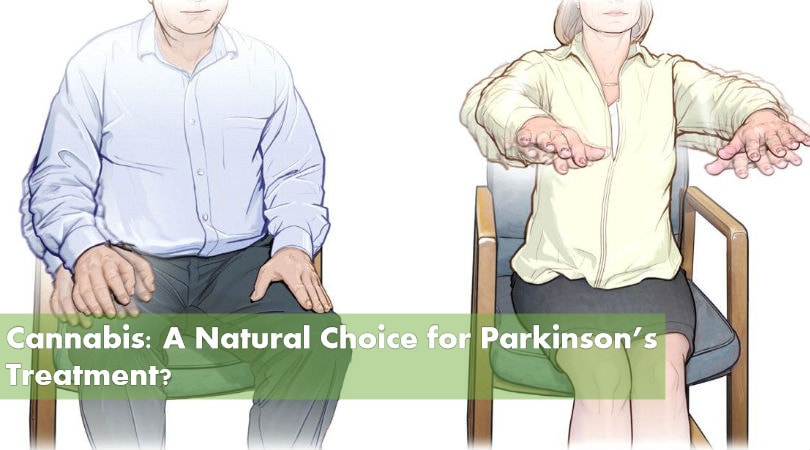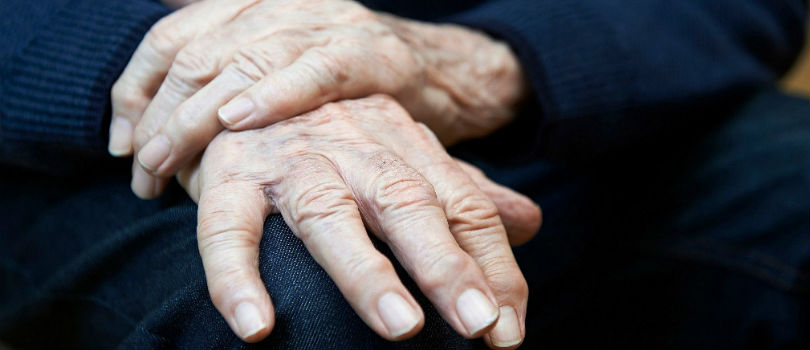Cannabis: A Natural Choice for Parkinson’s Treatment?
Marijuana has the potential to stop Parkinson’s in its tracks and improve the quality of life of those living with the disease. Over 10 million people worldwide suffer from Parkinson’s Disease, a disorder of the nervous system with no known cure. Parkinson’s Disease can result in many painful and unpleasant symptoms, but it is primarily characterized by problems with muscle control – which can manifest in different body parts. Since Parkinson’s has no cure, patients must rely on medication to manage their symptoms. Some of these medications have painful or unpleasant side effects, sometimes necessitating additional treatment with pharmaceutical painkillers. However, cannabis has attracted a lot of attention as a potential Parkinson’s treatment. Cannabis can provide relief from many Parkinson’s symptoms, as well as possibly protect key parts of the brain to prevent the disease from worsening.
Over 10 million people worldwide suffer from Parkinson’s Disease, a disorder of the nervous system with no known cure. Parkinson’s Disease can result in many painful and unpleasant symptoms, but it is primarily characterized by problems with muscle control – which can manifest in different body parts. Since Parkinson’s has no cure, patients must rely on medication to manage their symptoms. Some of these medications have painful or unpleasant side effects, sometimes necessitating additional treatment with pharmaceutical painkillers. However, cannabis has attracted a lot of attention as a potential Parkinson’s treatment. Cannabis can provide relief from many Parkinson’s symptoms, as well as possibly protect key parts of the brain to prevent the disease from worsening.
Marijuana and Parkinson’s
Certain chemical compounds (cannabinoids) in marijuana may be able to significantly impact the part of the brain that governs Parkinson’s Disease. The body actually produces its own cannabinoids – known as the “endocannabinoid system” – that bind to receptors throughout the body and brain and control many bodily processes, including appetite, mood, pain, and sleep. Movement – and movement disorders such as Parkinson’s – are largely affected by a part of the brain called the basal ganglia, which has an exceptionally high number of these cannabinoid receptors. The cannabinoids in marijuana are naturally and easily processed by the endocannabinoid system.
If dopamine-producing cells in the basal ganglia and other areas deep inside the brain begin to die (scientists still don’t know exactly what causes this and onset is typically slow), dopamine levels drop, and Parkinson’s Disease may develop. Dopamine is known as the body’s “reward” hormone, but it also governs movement, and lowered levels of dopamine can lead to problems with the entire muscular system. Everything from walking and writing to chewing and digestion can become difficult and painful. These muscular issues can fall into one or (often) more of the following categories:
● Bradykinesia
Bradykinesia is the involuntary slowing of movements. Actions like walking or standing can become very difficult, and the feet may drag when walking. Fine-motor activities such as writing or preparing food may also become labored and painful. Lowered dopamine levels contribute to bradykinesia.
● Dyskinesia
Dyskinesia is a condition that often arises in Parkinson’s patients as a result of a medication called levodopa. Levodopa is given to elevate dopamine levels, with the goal of achieving smooth motor function and alleviating bradykinesia and dystonia. An unfortunate side effect can be dyskinesia, characterized by jerky, unnatural, painful, involuntary movements. The pain can also contribute to trouble sleeping. Levodopa only appears to have this effect on those taking it for Parkinson’s Disease. Levodopa-induced dyskinesia is more prevalent in those under 70 years old who are taking the drug.
● Dystonia
Dystonia is another condition involving involuntary muscle movement, similar to dyskinesia. The difference is that dystonia causes the muscles to twist and then spasm or repetitively contract into unnatural and often painful positions.
Q: Does marijuana help Parkinson’s?
A: Marijuana has been shown to relieve many of the painful physical and psychological symptoms experienced by people with Parkinson’s Disease. It is also possible that compounds in marijuana may protect the brain from further damage and acceleration of the disease.

Certain chemical compounds in marijuana may be able to significantly impact the part of the brain that governs Parkinson’s Disease.
Medical Marijuana and Parkinson’s
Research on the effects of cannabis on Parkinson’s Disease and its various symptoms is still quite limited. Even so, many U.S. states have already approved medical marijuana as a treatment option. As the legal environment surrounding cannabis continues to improve, and more research is done on its medicinal benefits, it is likely that more states will approve its use for this and other conditions. Over a dozen patient advocacy groups, including the Michael J. Fox Foundation have been urging U.S. lawmakers to loosen legal restrictions that have kept clinical trials of medicinal marijuana so limited.
Of the U.S. states where medical marijuana is currently legal, Connecticut, Florida, Illinois, Lousiana, Massachusetts, Michigan, Missouri, New Hampshire, New Mexico, New York, Ohio, Pennsylvania, Vermont, and Puerto Rico all list Parkinson’s Disease as a qualifying condition for a prescription. However, some of the symptoms (such as chronic pain and muscle spasms) that Parkinson’s patients may develop do qualify in some of the other states where medical marijuana is legal. A few states (California, Oklahoma, and West Virginia) currently leave the decision of whether or not to prescribe medical marijuana completely at the discretion of physicians. In Canada this decision is also left up to physicians, but many are not comfortable prescribing medical marijuana for Parkinson’s until more research is done.
Q: How does medical marijuana help Parkinson’s?
A: Though not yet extensively studied, medical marijuana is sometimes prescribed to help Parkinson’s patients alleviate symptoms such as pain, stiffness, anxiety, depression, insomnia, and unintentional weight loss. It’s possible that medical marijuana also has a neuroprotective effect, keeping the disease from getting worse.
CBD and Parkinson’s
CBD (cannabidiol), a cannabinoid that’s beginning to get a lot of attention from researchers, shows promise as a potential Parkinson’s treatment. CBD is not psychoactive, so using it by itself will not cause a “high.” For this reason, CBD products are legal in all 50 U.S. states, including those where marijuana is not. CBD can be taken in the form of edibles, sprays, patches, or as a component of smokable marijuana. One of the most popular methods is ingesting CBD in the form of a highly concentrated oil.
The studies that have been done on CBD and movement disorders like Parkinson’s suggest that this cannabinoid could play a role in protecting against further neurological damage, and thus, the acceleration of the disease. CBD has also been shown to have an anti-inflammatory effect and to reduce the painful muscle stiffness and rigidity that afflicts approximately 70% of Parkinson’s patients. CBD also may improve symptoms of anxiety and depression, which over half of Parkinson’s patients experience at some point after their diagnosis. CBD also may help with the symptoms of psychosis (hallucinations, paranoia, and delusions) that afflict approximately 20% of Parkinson’s patients, often as a result of dopamine-enhancing medications.
Q: How does CBD oil help Parkinson’s?
A: CBD oil can significantly reduce pain, relax muscles, help with insomnia, and reduce symptoms of depression, anxiety, and psychosis. It also may have a neuroprotective and anti-oxidant effect on the brain, preventing Parkinson’s Disease from getting worse.

CBD shows promise as a potential Parkinson’s treatment.
THC and Parkinson’s
THC (tetrahydrocannabinol), the cannabinoid responsible for the “high” associated with marijuana, has several attributes that may make it an effective treatment for Parkinson’s. In addition to relieving pain, muscle spasms and nausea, inducing sleepiness, and boosting both mood and appetite, THC stimulates the brain’s dopamine receptors. Considering that low dopamine levels are directly linked to many of the painful symptoms of Parkinson’s, THC could potentially make a difference in treating the disease. More research is needed to further explore how THC may be able to help.
THCV and Parkinson’s
Another lesser-known cannabinoid, THCV (tetrahydrocannabivarin), may also be helpful in fighting Parkinson’s. Though chemically very similar to THC, in low doses, THCV does not give you a “high” or increase your appetite. But when taken at high doses or alongside THC, it “switches” and begins to create/enhance those same effects. Studies on rats and mice have indicated that THCV could alleviate tremors and similar motor function issues associated with Parkinson’s. This cannabinoid also may have a neuroprotective effect, helping to stave off further damage to the brain. THCV has also been suggested to be effective against inflammation and anxiety.
Other FAQ:Q: Does marijuana help Parkinson’s?
A: Marijuana has been shown to relieve many of the painful physical and psychological symptoms experienced by people with Parkinson’s Disease. It is also possible that compounds in marijuana may protect the brain from further damage and acceleration of the disease.Q: What kind of medical marijuana is effective for Parkinson’s?
A: More research is needed to determine the best balance of cannabinoids to treat Parkinson’s. As a general rule, different people may require different cannabinoid ratios to achieve optimal relief from their symptoms, and sometimes a balance of multiple marijuana strains (an energizing one for daytime, and sleep-inducing one for night, for instance) are the best option.Q: How long does it take to see results for Parkinson’s patients using medical marijuana?
A: Small scale studies have suggested that when cannabis is inhaled, relief from tremors sets in very quickly, and can last for 1-3 hours. Edible forms of marijuana (including CBD oil) may take an hour or more to begin to provide relief.

After was running around from doctor to doctor before we finally get rid of her PD ,at age 74 my mother noticed that her handwriting was getting smaller and I was writing faster as well. She also noticed a small tremor in her left hand. The doctor went over her different symptoms and he suspected she either had a small stroke or the beginnings of Parkinson ‘s disease. After finding a neurologist and some testing she was diagnosed with the beginning stages of Parkinson’s disease. That was 3 years ago. She take Sinimet four times a day to control the… Read more »